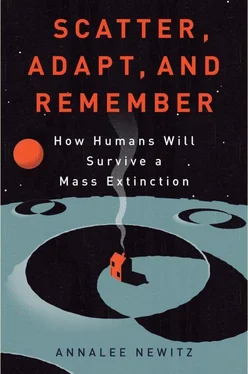His thoughts turned to what Bay Area residents call the Big One, or the next massive earthquake that could hit the region at pretty much any time. “We must be aware that the Big One will be strong, but I have some confidence that it’s going to be okay, and a minimal number of lives will be lost from collapsed buildings,” Takhirov said. Still, he wasn’t sanguine. “Unfortunately, the Big One is going to happen no matter what,” he said. And then, like a true engineer, he began imagining the discoveries such an event would yield. “When it happens, we will deploy all our cameras, and that will be our next big project.”
Other engineers are more fatalistic than Takhirov about how many lives they can save. One state north of Takhirov’s earthquake-simulation lab, on a hillside in the middle of Oregon’s Willamette National Forest, a U.S. Geological Survey (USGS) engineer named Richard Iverson has created hundreds of landslides to learn more about how these often deadly disasters start. He does his work at the USGS “debris-flow flume,” which is pretty much what it sounds like. It’s an outdoor laboratory that consists of a massive enclosed slide, adorned with cameras and embedded with sensors that measure everything from pressure to sheer force while fast-moving globs of mud, rocks, and water rush down the slope. When I spoke to him, he’d just finished a series of experiments where he and his colleagues sent debris flying into mud dams at the base of the flume. They were imitating a common and deadly scenario, where a mudslide temporarily dams a canyon, water builds up behind it, and then homes below are destroyed when the whole mess breaks open in a terrifying flood. After each experiment, Iverson feeds the data he’s gathered into predictive models, or computer programs that forecast disasters based on current conditions. Already, he said, he and his colleagues had learned more about flood warning signs after mudslides.
Research at the flume has led to an extremely sophisticated warning system on Mount Rainier in Washington. Several communities on the mountain suffer from periodic landslides due to water runoff, but Iverson and his colleagues were able to plot where these slides were most likely to start. They set up a warning system, a network of sensors that get tripped when a landslide’s characteristic ground vibration begins. When that happens, an alarm system is immediately set off and residents below get 30 to 45 minutes’ warning so that they can escape an event that often ends in death. Engineers at the flume also tested specialized wire nets that now lie like spiderwebs across the hillsides and cliffs above many highways in California, preventing small landslides from spilling onto cars or blocking the road.
Still, Iverson said, he feels like people in the United States don’t think enough about natural disasters when building cities and towns. “Some places really do make use of our predictions for guiding future development,” he replied. “But frankly, in the United States, with our history of zoning laws and development, it doesn’t get taken into great account.” He said that the big problem is that a lot of risky areas, such as the flood-prone Los Angeles canyons, were built up before anyone knew about the danger of mud slides. “You don’t always get to change much, so you do what you can.”
Ideally, Iverson said, he and his team would have enough resources to get detailed topographical maps of any part of Earth so that they could run landslide models of them and determine the safest places for people to build. “We could create probabilistic models for any area that we had data for, showing a range of possible events, from very likely and not so bad, to unlikely and very bad. Showing this information on maps would be very useful for planning purposes.” With the right amount of data, Iverson believes, he could give any planner a fairly realistic prediction about whether future cities might be in danger of getting buried in mud slides the next time a storm hits.
By destroying buildings and causing mud slides, Takhirov and Iverson are able to study disaster as scientifically as possible. What they’ve learned has already affected how cities are built, and how people evacuate flood zones. As we move into the future, however, we want cities that can do more than collapse without killing us. We want cities (and city emergency services) that can change instantly in response to imminent danger. Such cities, though they sound like science fiction, are already in the process of being designed.
Smart Cities and Disaster Prediction
City planners looking to the future often talk wistfully about data acquisition. With enough data about how natural disasters have unfolded in the past, prediction becomes much easier—especially when computers are involved, juggling thousands of data points every nanosecond to create a likely model of the future. That’s why IBM recently launched its Smarter Cities program, which is essentially a suite of software and services that the company sells to cities whose governments want to predict everything from traffic and crime patterns to the best exit strategy in a flood. The goal is to create cities whose traffic, food systems, energy grids, water management, and even health care are managed in a “smart” way, based on real-time data that reveals what’s needed where. This “big data” can come from almost any networked gadgets, including sensors, mobile phones, and GPS devices.
George Thomas, a former structural engineer, heads up the company’s Smarter Cities sales efforts, and has helped implement the program in several urban areas around the world. One of their first projects was to reduce traffic in Stockholm. First, IBM installed cameras over heavily trafficked roads near downtown to gather data. Once they had enough information, they were able to predict peak traffic hours every day. To reduce traffic, the city installed a ring of sensors around the city center that identify the license plates of every car passing through. If cars pass through during a period of high traffic congestion, drivers will automatically be charged a “congestion tax” at the end of the month. Almost immediately, the city found that more people took public transportation, carbon emissions went down, and city revenues went up. Most important, the traffic snarls around the Swedish city were gone.
One of the group’s current projects uses data that engineers like Iverson have been gathering about how mud slides and floods behave. Their goal is to give residents of Rio de Janeiro two days’ warning before the notoriously flood-prone region is inundated with water and mud gushing down from the mountains that ring the city. In the past, emergency responders have only had a six-hour window in which to evacuate, but that’s not long enough. With the city set to host the Olympics and soccer’s World Cup, Rio’s mayor decided to work with IBM to create a system that could predict floods as far in advance as possible. They needed what Thomas called a city operating system—a piece of software that could integrate streaming data from sensors on local flood plains and weather monitors. Working with all this data, the city’s operating system could convert many types of information into a predictive model that would change in real time. With the new system in place, people in Rio will have a full 48 hours to leave their homes and get out of the city before disaster strikes.
Of course, even the best-prepared regions are still going to suffer setbacks. Japan was unprepared for the calamity of the March 2011 earthquake and tsunami. Though the damaged Fukushima Daiichi Nuclear Power Station did have flood-protection walls, they weren’t high enough. And switches that would have brought backup power to the plant’s cooling units hadn’t been adequately flood-proofed either. Could a predictive system with enough data have helped disaster workers prepare for the event? Possibly, though in the wake of the disaster, officials discovered that workers had known about problems at Fukushima for years without addressing them. Predictions are only helpful if city builders are willing to act on them.
Читать дальше






![Аннали Ньюиц - Автономность [litres]](/books/424681/annali-nyuic-avtonomnost-litres-thumb.webp)





